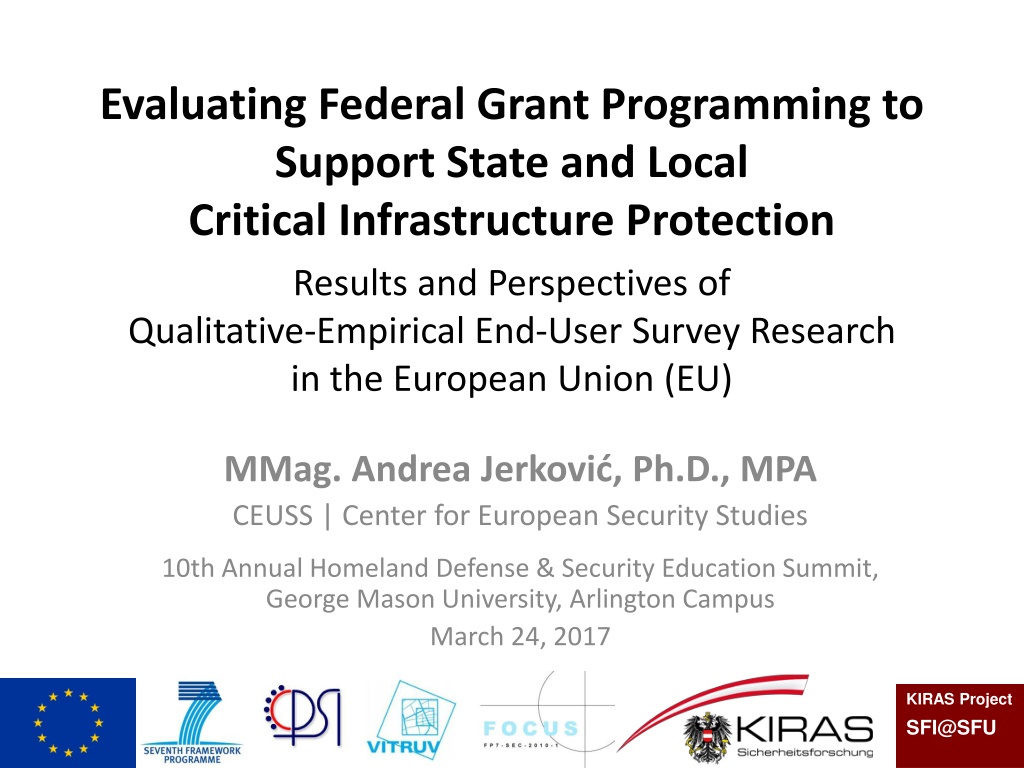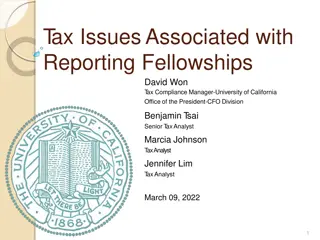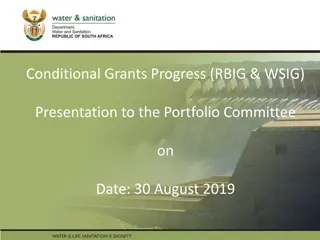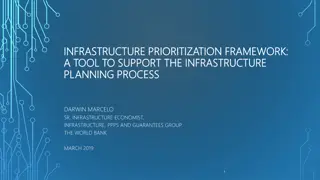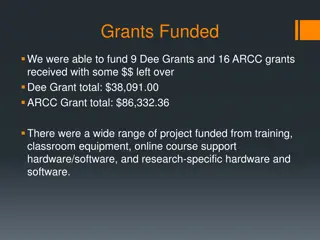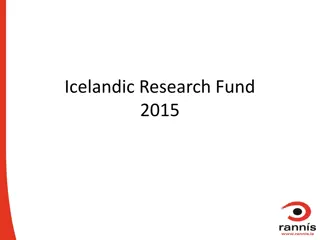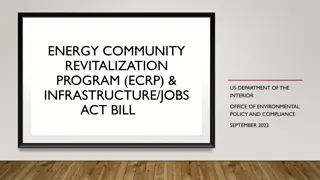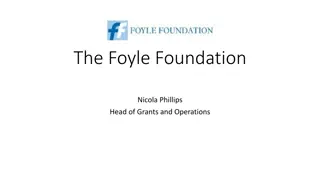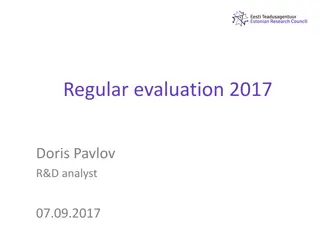Evaluation of EU Grants for Critical Infrastructure Protection
Comprehensive evaluation of federal grant programming in the EU focusing on state and local critical infrastructure protection. Results and perspectives obtained from qualitative-empirical end-user survey research shed light on perceptions, expectations, and demands at various levels. Insights from projects funded by Austrian Ministry of Technology, European Union programs, and more contribute to policy evolution and collaboration in the realm of civil security grants.
Download Presentation

Please find below an Image/Link to download the presentation.
The content on the website is provided AS IS for your information and personal use only. It may not be sold, licensed, or shared on other websites without obtaining consent from the author. Download presentation by click this link. If you encounter any issues during the download, it is possible that the publisher has removed the file from their server.
E N D
Presentation Transcript
Evaluating Federal Grant Programming to Support State and Local Critical Infrastructure Protection Results and Perspectives of Qualitative-Empirical End-User Survey Research in the European Union (EU) MMag. Andrea Jerkovi , Ph.D., MPA CEUSS | Center for European Security Studies 10th Annual Homeland Defense & Security Education Summit, George Mason University, Arlington Campus March 24, 2017 KIRAS Project SFI@SFU 1
Civil Security Grants in the EU Known as funding for Security Research, multipurpose: Combines research and preparedness grants RTD for response capabilities Networks of researchers and first responders Industrial and Technological Base Market and end-user demands-driven ( must be evidence based) European program as well as national programs in several Member States First national Security Research program: KIRAS (Austria), 2005 European program: Secure Societies topic in Horizon 2020 Lisbon Treaty (2009): Legal personality for the EU Solidarity Clause Support, enhance, and coordinate Member States civil protection Internal external security continuum, etc. Security Union with an own Commissioner in charge in DG HOME 2
Context Comprehensive presentation of selected main results of a series of surveys and foresight activities at Member State and EU levels (2009-2014) End-users form public and private sectors, identifying their perceptions and expectations as part of a comprehensive approach Technology, knowledge, and policy demands with regard to critical infrastructure protection at state and local levels Contribution to policy and program evaluation and evolution General lessons for innovation in preparedness and collaboration Covered in the EU U.S. Implementing Arrangement for Cooperative Activities in the Field of Homeland/Civil Security Research (2009) Recent DHS focus on working with the EU in research and policy Homeland security can benefit from international best practices and perspectives on its mission space (e.g. Morag, Comparative Homeland Security, 2011) President Trump s FY18 budget request may bring increased discussion of HLS grants between the federals and state and local partners Need for good understanding of state and local perception of grant programming and expectations in the federal government 3
Projects Covered The research leading to these results has received funding from: Austrian Ministry of Technology, Transport and Innovation (bmvit), Contract to populate the Austrian Security Research Map (http://landkarte.kiras.at/en) SFI@SFU: Development of an Austrian Centre for Comprehensive Security Research at Sigmund Freud Private University Vienna in the Austrian Security Research Program KIRAS European Union Seventh Framework Program (FP7/2007-2013) CPSI: Changing Perceptions of Security and Interventions; the European Union 7th Framework Program (Grant Agreement n 217881) VITRUV: Vulnerability Identification Tools for Resilience Enhancements of Urban Environments (Grant Agreement n 261741) FOCUS: Foresight Security Scenarios: Mapping Research to a Comprehensive Approach to Exogenous EU Roles (Grant Agreement n 261633). This presentation reflects only the author s views and the Union is not liable for any use that may be made of the information contained therein. 4
Approach Semi-structured end-user surveys (interviews and questionnaires) Based on program objectives analysis In formed by horizon scanning of emerging challenges and needs Action research component: Increase awareness of being an end-user in civil security/stakeholder in the European Security Model First used in a survey research study commissioned by the Ministry of Transport, Innovation and Technology (bmvit), Vienna in 2009 40 interviews completed Results populated the Austrian Security Research Map Expanded on in KIRAS project SFI@SFU (Austrian CoE) 90 end-users in a structured dialogue series Use in EU projects up to 2014, including the FOCUS project Scenario foresight to identify futuristic threats, demands, and requirements Collaboration with FEMA s Strategic Foresight Initiative and DHS S&T projects Multiple information collection methods used Total participation: approx. 600 experts from 20 countries 5
Critical Infrastructure Protection First mission in the EU s civil security acquis and related research programming: European Programme for Critical Infrastructure Protection (2006) Requires a common European risk assessment methodology focusing on cascading effects of systemic risks and a coherent European response during crisis and emergencies (European Agenda on Security, 2015) Thematic focus area in the Austrian Security Research Program KIRAS Based on OECD classification of critical infrastructures OECD screening study (2008): Significant commonalities in CIP challenges across Europe and North America, as well as around the world National specifics remain, for example: Challenge of aged infrastructure (U.S.) Focus on energy and transport sectors (EU) Main characteristics converge, such as the private sector as the main owner of, and investor in, critical infrastructure. 6
European CIP Programming Map Critical infrastructure (protection) is what states make of it Ownership of risks is an important aspect of security culture A comprehensive/whole-community approach must respect and integrate security cultures Risk assessment vs. cultural selection of risk (Douglas & Wildavsky, Risk and Culture, 1983) CPSI/ ESRIF Horizon Scanning Security Research program analysis 2009 7
Austria/KIRAS: Response Rates n 3 6 % Public Administration Home affairs First responder organizations Civil protection Health Utilities Transport Communication AUSTRIA 30% 75% 39% 40% 40% 38% 50% 0% 40% Response Rates by End-user Groups 12 6 4 5 4 0 40 AUSTRIA 40% Communication 0% Transport 50% Utilities 38% Health 40% Civil protection 40% First responder organizations 39% Home affairs 75% Public Administration 30% 8
Austria/KIRAS: Expectations in Grants Risk and vulnerability assessment ICT solutions Simulation tools S-T-L information management Functional support for state policies Little need for specific products Citizen-involving programs 10
EU/VITRUV: Urban Resilience How can security research programming better respond to urban planners needs to consider resilience aspects in urban infrastructure? Demand for studies higher then for concrete products, capabilities, or infrastructure projects funded by federal and EU grants: International state of the art and how prescriptive findings translate into different countries and jurisdictions Plans and models for Crime Protection Through Environmental Design, including addressing of ethics, legal and social issues (ELSI) Matching of protective measures for critical infrastructure with: Citizens perceptions of criticality Cultural patters of infrastructure use Potential for social acceptance of technological solutions Sustainability of urban processes/COB doctrine for the city Coordination of risk management and emergency management plans and practices with specific critical infrastructure protection needs 11
EU/FOCUS: Security Union 2035 In order to support preparedness for a resilient EU and Security Union to comprehensively deliver security to its citizens, EU grant programs should focus on topics and projects that: Facilitate information sharing Facilitate anticipation and foresight of threats in line with the objectives of the European Security Model (anticipate, prevent, protect) Address the internal external continuum in critical infrastructure protection Raise awareness and increase broad sense of ownership in the European Security Model and protection of critical infrastructure across levels of designation (National Critical Infrastructure, or NCI, and European Critical Infrastructure, or ECI) Support evidence-based and effects-based approaches, for example: Socio-technical analyses of cross-sector threats to critical infrastructures Wider impact scenarios 12
EU/FOCUS Foresight vs. Current The following chart illustrates anticipated needs for Preparedness 2035 (purple) vs. current strategies and programs focus in the EU (blue) 13% Knowledge/anticipation/foresight 1% Internal-external threat/security continuum 8% 2% 7% Resilience/ownership 4% 7% Effects-based approach to operations 5% 17% Information sharing 5% All-societal outreach and transfer of knowledge 4% 6% Developement of capabilities, including cross-cutting capabilties 5% 8% Integrated assessment and decision making (systemic approach) 9% 10% International combination of capabilities/pooling 8% 10% Coordination between autonomous actors 11% 12% 0% 2% 4% 6% 8% 10% 12% 14% 16% 18% FOCUS General Expert Questionnaire results Analysis of definitions of "comprehensive approach" in forward-looking strategic documents 13
Cross-Findings Lowest awareness and acceptance of initiatives and grants for infrastructure protection: Public Administration Highest awareness and acceptance of initiatives and grants for infrastructure protection: Transportation Sector Strong demand for infrastructure assessment studies Reactivity analysis: Need for improved recognition of state and local security cultures State and local authorities have vested interests in their specific risks and emergencies, take ownership in them, and make them part of their identity (cf. Wuthnow, Be Very Afraid, 2010) Tunnel effect related to state-specific types of infrastructure and related issues; strong sense of ownership Identity-shaping effect of infrastructure and risks, where preparedness can be threatening Need to analyze risks comprehensively and to involve all parts and levels of society involved in the production of security as a public good 14
Utility of Studies Results Austria & Security Research Program KIRAS Support development of a related nation-wide database and map Propose additional policy and program evaluation criteria Raise awareness to increase active end-user community Identify topics for calls to increase program responsiveness to state and local demands Increase chances for take-up of results and marketability of products EU Security Research Identify topics for calls in Horizon 2020 Support EU agencies such as FRONTEX and EDA in strategic prioritization EU and Member State Civil Security Contribute content to Urban Securipedia, a knowledge base to support risk assessment for resilience-enhancing urban planning Raise awareness of stakeholdership in security research and the European Security Model 15
Possible Next Steps in U.S. Context Expanding on the 2009 U.S.-EU Implementing Arrangement: Empower subsequent-tier actors to reach their mission goals, while fostering state and local ownership Scalable, adaptable ways of studying risk perception of end-users and practitioners at state, and local levels, and related expectations in homeland security policy and programs Contexts and practices across SLTT:Treatment-as-a-State (TAS) has put responsibility for federal grants in the hand of tribes Studies to assess perceptions, needs, and expectations within a context that affirms cultural diversity Recent Executive Orders on Protecting the Homeland and subsequent DHS Implementation Memoranda emphasize working across tiers of government, from federal to local: Improved connection of federal with state and local implementing action, as well as a more direct role of the U.S. Department of Homeland Security in enabling state and local actors Some criticism regarding state and local sovereignty and ownership Presented studies action research component can be of value 16
Thank you! Contact: jerkovic@european-security.info Institutions where work was completed: CEUSS | Center for European Security Studies http://www.european-security.info SFI | Institute for Security Research, Sigmund Freud University, Vienna, Austria http://www.esci.at/sfi-sfu Security Research Map Austrian Security Research Program KIRAS http://landkarte.kiras.at/en 17
